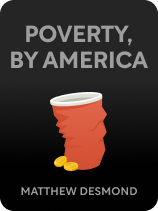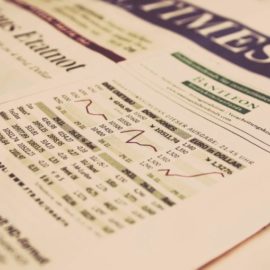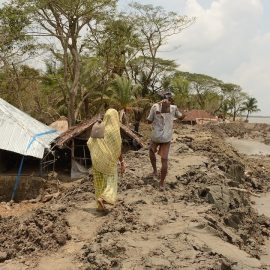
How many Americans live in poverty? Why would a prosperous nation have impoverished people?
Poverty, by America by Matthew Desmond contends that the United States has a big problem. Despite the country’s vast wealth and prosperity, it suffers from a level of poverty and inequality unseen anywhere else in the developed world.
Continue reading for an overview of this new book.
Overview of Poverty, by America by Matthew Desmond
According to Poverty, by America by Matthew Desmond, one in nine Americans and one in eight children live in poverty (defined by the US federal government in 2023 as an individual earning less than $14,580 per year or less than $30,000 for a family of four). Desmond writes that a smaller—but still shockingly high—number of Americans live in deep poverty, on par with the poverty of the poorest people in developing nations like India or Bangladesh.
How can this level of abject misery and deprivation exist in a country as wealthy as the United States, with a GDP higher than the combined total of the next five largest economies? This is the core question that Desmond seeks to answer. According to him, poverty in America persists because it benefits many Americans to keep a share of their fellow Americans in a state of want—and he issues a moral call to arms to readers to examine their role and responsibility in benefiting from and perpetuating the cycle of poverty.
Desmond is a professor at Princeton University, and he’s written a number of books, including the Pulitzer Prize-winning Evicted: Poverty and Profit in the American City. His research centers on inequality and public policy, fueled by his own experience of poverty. Poverty, by America was published in 2023.
We’ll explore some of the key points raised by Desmond including:
- The lived experience of poverty in America and its devastating social consequences
- The false explanations for why people are poor—and stay poor
- How non-poor Americans benefit from the poverty of their fellow Americans
- The choices we can make—both at a policy and individual level—to empower the poor and eradicate poverty
Part 1: The Lived Experience and Consequences of Poverty
The US federal government defines poverty in 2023 as an individual earning less than $14,580 per year or less than $30,000 for a family of four. But, writes Desmond, poverty is far more than just a lack of income and can’t be reduced to a simple math equation. To truly understand the phenomenon of poverty in America, writes Desmond, it’s crucial to explore what it actually feels like to be poor.
He writes that poverty is a complex state of being, encompassing a multitude of experiences, emotions, and consequences that go far beyond financial hardship. Desmond stresses that poverty is a wrenching, soul-crushing experience, imbued with physical and psychic pain, representing a loss of freedom, agency, choice, and options for those ensnared by its grasp.
The consequences of poverty are dire and far-reaching. It leads to premature death, illness, drug addiction, violence, homelessness, and sexual abuse and assault. It is the common thread that connects America’s social problems, contributing to issues such as lack of education, health disparities, and crime.
Part 2: False Explanations for Poverty
Having established the true costs of poverty, Desmond explores why poverty remains such a persistent feature of American life despite the United States’ economy being large and wealthy enough to raise every adult and child above the defined poverty level. He writes that, since the federal anti-poverty initiatives of the 1960s, there has been little sustained progress against poverty rates despite substantial spending on programs designed to combat poverty over the past 50 years.
The stubborn persistence of poverty has given rise to several false explanations for its staying power, including immigration, non-traditional family structures, and a bad work ethic among the poor.
False Explanation #1: Immigration
Desmond writes that immigrants are often wrongly associated with higher poverty rates, with immigration levels cited as a reason for the endurance of poverty. However, he notes, this is false: Immigrants exhibit higher levels of social mobility—the ability to move up and down the social and economic ladder—than native-born Americans. Moreover, they typically use fewer state resources and services, and states with more immigrants often have lower poverty rates.
False Explanation #2: Non-Traditional Family Structures
Desmond notes that non-traditional family structures are often held up as a reason for poverty’s endurance. Before we explore Desmond’s arguments for why this isn’t true, it’s worth looking at what advocates of this theory say about the link between family structure and poverty.
The argument is that these non-traditional family structures (for example, single parenthood or out-of-wedlock children) contribute to poverty by reducing economic stability. For example, a single mother must balance working to provide for her family with the responsibilities of childcare. Her income is limited because she can’t work full-time. In this scenario, the non-traditional family structure leads to greater economic instability, stretching the mom’s financial resources thin and making it difficult for her to cover basic necessities like housing, food, and healthcare.
Thus, according to this argument, traditional family structures where two parents share both financial and caregiving responsibilities might provide greater economic stability for the family, as they can pool their resources and share the burden of childcare.
However, Desmond raises a few objections to the theory that non-traditional family structures contribute to poverty. For example, he notes the lack of a link between family structure and poverty in other countries and the fact that marriage and family formation are steps people take after they’ve already achieved a certain level of financial stability. Let’s explore each of his objections in detail.
1) Non-Traditional Families Aren’t Inherently Poorer Anywhere Else
Desmond observes that changes to the traditional married, two-parent family structure aren’t inherently linked to poverty in other countries. If it was a universal truth that non-traditional family structures led to poverty, we would expect it to be a global phenomenon.
Desmond writes that America’s key difference is a lack of childcare options, which governments do offer in other wealthy, industrialized nations. This is what makes it nearly impossible for single parents to work full-time, meaning they’re unable to reach their full earning potential—making it far more likely that they’ll wind up in poverty. In other words, being a single parent isn’t in and of itself what makes someone poor—being a single parent while having to pay for or provide childcare with minimal assistance is what makes someone poor.
2) Poverty Prevents Family Formation
Desmond further writes that those who cite non-traditional family structures as a reason for poverty’s staying power get the causal relationship wrong. People aren’t poor because they don’t start families; they can’t start families because they’re poor.
According to Desmond, it requires a certain level of financial stability to get married in the first place. When individuals or couples are struggling to make ends meet, they may delay or forgo marriage and starting a family because they believe they lack the financial resources to support a family. This can be particularly pronounced in communities with high living costs, limited job opportunities, or inadequate social safety nets. In other words, writes Desmond, marriage and family formation is something people do after they’ve achieved a certain level of financial stability. It’s a marker of prosperity, not a cause of it.
False Explanation #3: Lack of Work Ethic
Desmond observes that politicians often associate poverty with a perceived lack of work ethic.
Desmond also finds this argument lacking. He notes that, during the Covid-19 pandemic, the CARES Act, which among other provisions provided direct cash assistance and expanded unemployment insurance to families living in poverty, demonstrably alleviated poverty rates during the time those benefits were being distributed. He writes that some politicians saw the cash transfers as a negative, believing it disincentivized people from seeking employment if it was more lucrative to stay home and collect government checks. According to Desmond, this is a manifestation of an ideology that the poor must be kept miserable and starving—so they’ll be motivated to work.
If it were true, however, that the benefits from the CARES Act were discouraging work, then we’d expect to see an increase in the employment rate once the benefits expired. But, as Desmond notes, this isn’t what happened at all. The expiration of benefits brought no appreciable increase in the employment rate—unsurprising, since during the pandemic, people likely stayed home from work for other reasons (such as to care for children during school shutdowns or out of fear of getting infected).
Part 3: How Wealthy Americans Exploit Poverty
Since we’ve explored how and why the commonly cited explanations for poverty fall flat, let’s turn our attention to what Desmond argues does explain the persistence of poverty in America. He writes that the primary force perpetuating poverty is the non-poor Americans who benefit from keeping their fellow Americans poor. According to Desmond, it’s a story of exploitation and appropriation, where choices made by individuals and society at large contribute to the immiseration of millions.
We’ll explore the choices we make to create the poverty of others, including our demands as consumers for cheap goods and convenient services, how and where we invest our money, and where we choose to live. We’ll also explore some of the more specific modes of exploitation, including rent gouging by unscrupulous landlords, the predatory shadow banking system, and housing discrimination.
The Consequences of Our Consumer Choices
Desmond writes that the choices we make as consumers contribute to the poverty of others.
Many of these choices are related to our demands for cheap goods and our expectations of instantaneous service and deliveries of those goods. The low prices and same-day deliveries offered by e-commerce giants like Amazon or food delivery services like Seamless aren’t possible solely because of technological innovation. Rather, writes Desmond, behind these conveniences is a vast underclass of underpaid drivers, exploited kitchen workers, and un-unionized warehouse employees. Their poverty and exploitation are the hidden costs of our material comfort.
Investment Decisions and Privilege
According to Desmond, we also contribute to poverty through our investment decisions.
The most profitable companies to invest in and buy stock in are often those that boost their profit margins by keeping workers underpaid, without union representation, and laboring under poor and unsafe conditions. When you invest in those companies—whether you’re an active stock trader or are just passively and indirectly investing in them through a retirement account like a 401k—you’re both rewarding those companies for exploiting their workers and profiting off that exploitation.
Keeping the Poor Out of Our Neighborhoods
Desmond writes that the places we choose to live and the local housing rules we make are powerful contributors to entrenched poverty.
Wealthier neighborhoods often pass zoning laws that prohibit the construction of multi-family houses and apartment buildings. Because these latter types of homes tend to be more affordable, these policies have the effect of locking poor people out of more affluent neighborhoods—trapping them in poor communities with generational poverty.
These policies also keep the supply of available and affordable housing low. This means they raise the cost of housing and protect the real estate investments of incumbent homeowners—another way that our lifestyle choices increase our material comfort at the expense of the poor.
Rents and Landlords
Desmond writes that one effect of these exclusionary zoning policies is to pack poor people—who are disproportionately Black and Latino—into pockets of poverty, often in urban slums. And those urban slums are often a gold mine for landlords who charge higher rents for dilapidated buildings and apartments compared to those in more affluent neighborhoods.
This is because landlords can extract every dollar out of old and inadequate housing stock by dividing them into smaller and smaller apartments for people who have no other option of where to live. The desperation and disempowerment of their tenants is what allows landlords to gouge them this way. Indeed, writes Desmond, in many parts of America it’s more profitable to be a landlord in a poor neighborhood than in a wealthy one. The situation has only gotten worse since 2000, with median rent increasing more than two and a half times—far outpacing inflation and the meager wage increases over that time.
The Shadow Banking System
Another way that the economic system preys on the poor is through the system of “shadow banking.” According to Desmond, many individuals experiencing poverty find themselves locked out of the traditional banking system because they lack credit or proper paperwork to open accounts. Consequently, shadow banking options, like payday lenders and check cashers, step in to fill the void. They charge exorbitant rates and fees, effectively taking around $61 million in such fees per day from the poorest Americans. Desmond writes that this essentially amounts to the theft of labor.
And, he notes, it’s a self-reinforcing cycle. The bad credit that comes from poverty forces people to rely more on fringe banking options, whose ruinous interest charges drive them even further into poverty. All of this creates a lucrative industry for the lenders.
Part 4: Empowering the Poor: A Multifaceted Approach to Eradicate Poverty
To truly alleviate poverty, writes Desmond, it’s essential to go beyond providing financial assistance, although that’s undeniably important. He argues that to eradicate poverty, we need to empower the poor, granting them economic and political agency to shape their economic futures.
We’ll explore the necessary multifaceted approach: strengthening unions to enhance collective bargaining power, creating paths to homeownership, ending exclusionary zoning policies, and cracking down on welfare for the rich.
Empowerment Strategy #1: Strengthen Unions
One powerful way to empower workers, writes Desmond, is to reinvigorate the labor movement and strengthen unions. The existing legal framework, which requires workers to organize company by company, often puts unions in a disadvantaged position—since employees at each company need to mobilize and negotiate separately, requiring unions to invest significant time, effort, and resources in the logistics of coordinating this. This fragmentation of organizing efforts can also make it easier for employers to target and disrupt specific campaigns.
Sectoral bargaining, writes Desmond, offers an alternative that would empower labor in negotiations with employers, benefitting even employees who are not union members. Sectoral bargaining allows workers from multiple companies within the same industry or sector to negotiate collectively. This increases workers’ leverage and can lead to potentially better outcomes in terms of wages, benefits, and working conditions. And when agreements are reached that cover all employees in a sector, non-union members often receive the same improvements in their conditions as union members. This inclusivity promotes solidarity among workers.
Empowerment Strategy #2: Create Paths to Homeownership
Desmond writes that homeownership can be a path to financial stability for many. However, as we’ve seen, people in poverty face significant hurdles along the path to homeownership—further perpetuating the cycle of poverty. One proposal, writes Desmond, is government guarantees of home loans for disadvantaged borrowers. This would help such borrowers bypass the banks (who, as we saw, see little profit in mortgages for affordable homes and are therefore less likely to issue those kinds of mortgages) and open the doors to generational wealth.
Empowerment Strategy #3: End Exclusionary Zoning
Desmond writes that providing people in poverty with the opportunity to move into wealthier neighborhoods has a demonstrable impact on their economic well-being. But, as we’ve seen, exclusionary zoning rules often create an impossible barrier. Abolishing exclusionary zoning rules (like bans on multifamily housing) and implementing mandatory inclusionary zoning rules (like requiring a certain proportion of multifamily housing) can break down that barrier. And, despite the fears of incumbent homeowners, affordable housing—when managed properly—does not negatively affect neighboring property values.
Desmond urges individuals to become anti-poverty crusaders in this regard by actively participating in local zoning or planning boards to help ensure affordable housing and integrated neighborhoods become a reality.
Empowerment Strategy #4: Crack Down on Welfare for the Rich
Desmond further recommends cracking down on the nation’s exorbitant welfare for the rich—largely through preferential treatment in the tax code—and reinvesting it into anti-poverty initiatives.
He notes that there is approximately $1 trillion in unpaid tax annually, a disproportionate share of which comes from the wealthy. He recommends stepping up enforcement of these unpaid taxes, while also increasing the top marginal rate (the taxes on the portion of income that falls within the highest income bracket) and corporate tax rates, which currently stand at nearly half of what they were in the 1970s. Finally, he urges lawmakers to close tax loopholes, such as the mortgage interest deduction which overwhelmingly benefits the affluent, and tax capital gains (taxes on profits earned from the sale of assets, such as stocks or real estate) at rates equal to ordinary income, so that corporate shareholders pay the same rate as workers.

———End of Preview———
Like what you just read? Read the rest of the world's best book summary and analysis of Matthew Desmond's "Poverty, by America" at Shortform.
Here's what you'll find in our full Poverty, by America summary:
- Why the United States suffers from so much poverty and inequality
- How some Americans benefit from the poverty of others
- How we can empower the poor and eradicate poverty






